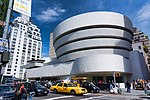American Academy of the Fine Arts
1802 establishments in New York (state)Art schools in New York CityEducational institutions established in 1802Learned societies of the United States
The American Academy of the Fine Arts was an art institution founded in 1802 in New York City, to encourage appreciation and teaching of the classical style. It exhibited copies of classical works and encouraged artists to emulate the classical in their work. The mayor of New York city at the time, Richard Varick, and Gulian Verplanck, a New York politician, were some of the Academy's original organizers. Younger artists grew increasingly restive under its constraint, and in 1825 left to found the National Academy of Design.
Excerpt from the Wikipedia article American Academy of the Fine Arts (License: CC BY-SA 3.0, Authors).American Academy of the Fine Arts
5th Avenue, New York Manhattan
Geographical coordinates (GPS) Address Nearby Places Show on map
Geographical coordinates (GPS)
| Latitude | Longitude |
|---|---|
| N 40.78367 ° | E -73.95867 ° |
Address
National Academy of Design
5th Avenue 1083
10128 New York, Manhattan
New York, United States
Open on Google Maps








